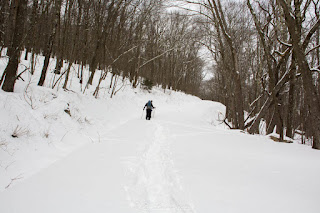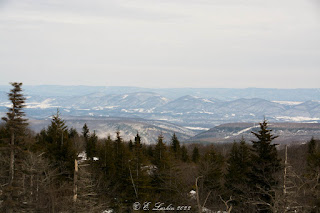I'm going to give this blogging thing a try again. It has been a couple of years...quite a couple of years. But here I am and I'm still outside. I just haven't been writing as much about it. I have been posting on instagram, so it is worth checking that out, too.
We snowshoed up into Dolly Sods today with a friend. We started at the gate on the north side of Forest Road (FR) 75.* There were a couple of inches of snow where we parked. It quickly became 6 inches as we walked up the road. Then after the first mile, it was more like 12 inches. It kept getting deeper all the way up the road until the very top of the plateau. Just below Bear Rocks, the snow was suddenly gone, having been scoured away by the constant wind up there. Wherever there was shelter, there were snow drifts. We made the three miles uphill to Bear Rocks in decent time. Then we spent some time at the cliffs on top of the plateau. It was a pretty magical, perfect weather day: temperatures in the low 20s and little wind. We had originally intended to hike yesterday, but our friend had a conflict. That turned out to be a good thing: yesterday, the high was about 10 degrees and the winds were gusting over 50 mph.
We only saw one group the entire day: a group of six that were woefully underprepared for the night they had just spent out. They were in good spirits, at least, and headed out, so they were going to be fine.
*So, a few thoughts about visiting Dolly Sods in winter because we've encountered a few groups that seemed surprised by these things over the past few years.
- Unless you are staying in Old Timberline, there is no way reliable way to drive up to Dolly Sods in winter. The US Forest Service gates both FR 75 and FR19. I don't think FR 80 is gated, but it also isn't plowed. At all. This means that however you go, you will have a long approach walk. It is three miles from where we parked today to Bear Rocks, on the eastern edge of the plateau. It is all uphill to get up there. It isn't super steep, but it is a steady climb. FR 75 absolutely needed an AWD vehicle today just to get to the gate. I've seen several parties pull up to the gate there completely surprised that they couldn't drive up.
- Weather: The weather can be really harsh up there. If it is breezy and chilly down in the valley, or where you live, you can bet it is gale force winds and frozen up in Dolly Sods. We were up on the west side of Dolly Sods two weeks ago and it was so windy that it was difficult to stand. I've also been lucky enough to be up there when it is cold but there is little wind. Those days are pretty magical. If it has been warm, it will be a muddy mess up there in the winter. My point of all of this? Hiking in Dolly Sods in winter requires you to be prepared for harsh conditions.
Wind scour lines in a snow drift
Looking out over the valley to the east
Michael near Bear Rocks
North Fork Mountain in the distance
Flagged trees near Bear Rocks.


























































